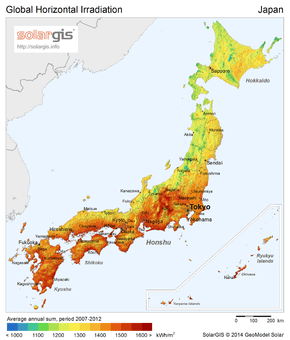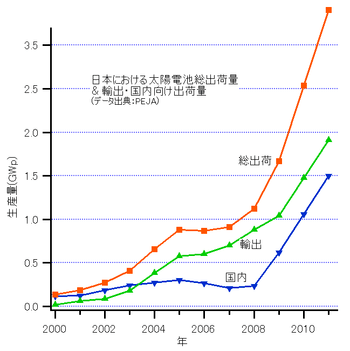Solar power in Japan

Solar power in Japan has been expanding since the late 1990s. The country is a leading manufacturer of photovoltaics (PV) and a large installer of domestic PV systems with most of them grid connected.[1] Japan has an insolation of about 4.3 to 4.8 kWh/(m²·day).
Solar power has become an important national priority since the country's shift in policies toward renewable energy after the Fukushima Daiichi nuclear disaster in 2011.[2][3] Japan was the world's second largest market for solar PV growth in 2013 and 2014, adding a record 6.97 GW and 9.74 GW of nominal nameplate capacity, respectively. By the end of 2017, cumulative capacity reached 50 GW, the world's second largest solar PV installed capacity, behind China.[4][5] Overall installed capacity in 2016 was estimated to be sufficient to supply almost 5% of the nation's annual electricity demand.[4]
Government action
Feed-in tariff
The Japanese government is seeking to expand solar power by enacting subsidies and a feed-in tariff (FIT). In December 2008, the Ministry of Economy, Trade and Industry announced a goal of 70% of new homes having solar power installed, and would be spending $145 million in the first quarter of 2009 to encourage home solar power.[6] The government enacted a feed-in tariff on November, 2009 that requires utilities to purchase excess solar power sent to the grid by homes and businesses and pay twice the standard electricity rate for that power.[7]
On June 18, 2012, a new feed-in tariff was approved, of 42 Yen/kWh. The tariff covers the first ten years of excess generation for systems less than 10 kW, and generation for twenty years for systems over 10 kW. It became effective July 1, 2012.[8] In April 2013, the FIT was reduced to 37.8 Yen/kWh.[9] The FIT was further reduced to 32 Yen/kWh in April 2014.[10]
In March 2016, a new feed-in tariff was approved. The Procurement Price Calculation Committee compiled and publicized recommendations concerning the FY 2016 purchase prices and the periods therefor. Respecting the recommendations, METI finalized the prices and periods therefor as below.
(1) Electricity generated by photovoltaic power for non-household customers (10 kW or more) was reduced from 27 yen/kWh to 24 yen/kWh.
(2) Electricity generated by photovoltaic power for household customers (10 kW or less) was reduced from 33 yen/kWh to 31 yen/kWh when generators are not required to have output control equipment installed. When generators are required to have output control equipment installed the price was reduced from 35 yen/kWh to 33 yen/kWh. [11]
Residential PV feed-in tariffs for systems below 10 kW were updated in 2017 to values between JPY24/kWh to JPY28/kWh depending on the circumstances. These will remain unchanged until 2019.[12]
The most recent FIT only concerns non-residential solar power plants. The new non-residential FIT will go from JPY21/kWh in 2017 to JPY18/kWh for facilities certified in and after April 2018.[12]
Targets
The government set solar PV targets in 2004 and revised them in 2009:[13]
- 28 GW of solar PV capacity by 2020
- 53 GW of solar PV capacity by 2030
- 10% of total domestic primary energy demand met with solar PV by 2050
The targets set for 2020 were surpassed in 2014, and the target for 2030 was surpassed in 2018.
New targets were adopted after 2011.

Solar manufacturing industry
Japan is a leading manufacturer of photovoltaics. In other words, photovoltaic devices use semiconductors in order to generate electricity from the sunlight. [14]Solar companies of Japan include: Kyocera, Mitsubishi Electric, Mitsubishi Heavy Industries, Sanyo, Sharp Solar, Solar Frontier, and Toshiba.
Notable projects

The Solar Ark, built in 2002, is one of the largest solar buildings in the world.[15]
After the shift away from a nuclear power-dependent energy policy in the wake of the Fukushima nuclear accident,[16] the first three solar plants by TEPCO were completed in 2011 and 2012, the Ukishima Solar Power Plant, 7 MW, the Ogishima Solar Power Plant, 13 MW, and the Komekurayama Solar Power Plant, 10 MW. The output of all three can be monitored on the internet.[17]
341 MW of photovoltaics are planned for the island of Hokkaido, and a total of 1,800 MW of photovoltaics projects have been approved for Japan, as of October 2012.[18]
Additional projects include the 70MW Kagoshima Nanatsujima Mega Solar Power Plant by Kyocera in Kagoshima Prefecture that went online in November 2013 and a 100 MW plant by Toshiba in Minami Soma, Fukushima Prefecture.[19][20]
A 77 MW photovoltaic power plant is planned for Tahara City, on the Atsumi Peninsula, and is expected to be completed in 2014.[21] A 200 MW plant is proposed for Tomakomai.[22]
Another recent project starting in 2017 will include a floating solar farm on the Yamakura Dam. This project will provide enough power for 5,000 households in Japan. It is said to be completed in 2018 and will be located on a reservoir in Japan's Chiba prefecture. [23]
It is expected that many new projects will be constructed, to take advantage of the new feed-in tariff.
Photovoltaics installed capacity and generation
| Year End |
Total Capacity |
Yearly Installation |
|---|---|---|
| 1992 | 19.0 | n/a |
| 1993 | 24.3 | 5.3 |
| 1994 | 31.2 | 6.9 |
| 1995 | 43.4 | 12.2 |
| 1996 | 59.6 | 16.2 |
| 1997 | 91.3 | 31.7 |
| 1998 | 133 | 41.7 |
| 1999 | 209 | 76 |
| 2000 | 330 | 121 |
| 2001 | 453 | 123 |
| 2002 | 637 | 184 |
| 2003 | 860 | 223 |
| 2004 | 1,132 | 272 |
| 2005 | 1,422 | 290 |
| 2006 | 1,709 | 287 |
| 2007 | 1,919 | 210 |
| 2008 | 2,144 | 225 |
| 2009 | 2,627 | 483 |
| 2010 | 3,618 | 991 |
| 2011 | 4,914 | 1,296 |
| 2012 | 6,632 | 1,718 |
| 2013 | 13,599 | 6,967 |
| 2014 | 23,339 | 9,740 |
| 2015 | 34,150 | 10,811 |
| 2016[4] | 42,750 | 8,600 |
| 2017[5] | 49,750 | 7,000 |
| Source: EPIA and IEA-PVPS. All nominal capacity figures are reconverted from WAC to Wp.[24][25] | ||
| Year | Generation (% of consumption) |
|---|---|
| 2010[26] | 0.3% |
| 2011[27] | 0.5% |
| 2012[28] | 0.7% |
| 2013[29] | 1.4% |
| 2014[30] | 2.4% |
| 2015[31] | 3.5% |
| 2016[4] | 4.9% |
| 2017[32] | 5.9% |
See also
References
- ↑ "Cumulative Installed Solar Photovoltaics Capacity in Leading Countries and the World, 2000-2013". Earth Policy Institute. June 18, 2014. Retrieved 2014-09-03.
- ↑ "Solar Energy in Japan - Summary". GENI. Retrieved 7 May 2012.
- ↑ Chisaki Watanabe (August 26, 2011). "Japan Spurs Solar, Wind Energy With Subsidies, in Shift From Nuclear Power". Bloomberg.
- 1 2 3 4 "Snapshot of Global Photovoltaic Markets 2017" (PDF). report. International Energy Agency. 19 April 2017. Retrieved 27 April 2017.
- 1 2 Pv-magazine FEBRUARY 15, 2018. "Japan will likely install 6 GW to 7.5 GW (DC) of solar in 2018, from about 7 GW in 2017..."
- ↑ Japan renews focus on solar power
- ↑ Soto, Shigeru (2010-02-09). "Japan's Solar Panel Sales Rise to Record on Subsidy (Update1)". BusinessWeek. Retrieved 2010-09-10.
- ↑ Japan Approves Feed-in Tariffs
- ↑ Japan’s High-Cost Renewable Energy Curbs Subsidy Impact
- ↑ Chisaki Watanabe (March 2014). "Japan Cuts Subsidy for Solar Power, Boosts Offshore Wind". Bloomberg News. Retrieved 2014-04-02.
- ↑
- 1 2 "Japan to slash feed-in-tariffs for solar plants this year". AsianPower. Retrieved 25 March 2018.
- ↑ Yamamoto, Masamichi; Ikki, Osamu (2010-05-28). "National survey report of PV Power Applications in Japan 2009" (PDF). International Energy Agency. Retrieved 2017-04-02.
- ↑ "Photovoltaic (Solar Electric)". Retrieved 24 March 2018.
- ↑ Kriscenski, Ali. "SOLAR ARK: World's Most Stunning Solar Building". inhabitat. Retrieved 19 April 2018.
- ↑ UN cites solar potential as Japan scraps nuclear plan
- ↑ Solar Power Plant Facility Overview
- ↑ Mega solar power plants may be excessively concentrated in Hokkaido.
- ↑ Now Toshiba says they’re building Japan’s ‘largest’ solar plant in Fukushima
- ↑ Utility-scale solar plant for Fukushima
- ↑ One of Japan's Largest Mega Solar Projects to be Built in Aichi
- ↑ Japan to see a solar power boom
- ↑ Vaughan, Adam. "Japan begins work on 'world's largest' floating solar farm". The Guardian. Retrieved January 27, 2016.
- ↑ "National Survey Report of PV Power Applications in Japan - 2012 - Third Version". International Energy Agency. 2013-06-10. Retrieved 2014-04-13.
- ↑ "Global 2013 solar installs hit 37GW: EPIA". PV-Tech. 2014-03-06. Retrieved 2014-04-13.
- ↑ Masamichi Yamamoto & Osamu Ikki (2011-07-15). "National Survey Report of PV Power Applications in Japan - 2010". International Energy Agency. Retrieved 2015-08-14.
- ↑ Hiroyuki Yamada & Osamu Ikki (2012-05-31). "National Survey Report of PV Power Applications in Japan - 2011". International Energy Agency. Retrieved 2015-08-14.
- ↑ Hiroyuki Yamada & Osamu Ikki (2014-08-27). "National Survey Report of PV Power Applications in Japan - 2013". International Energy Agency. Retrieved 2015-08-14.
- ↑ Hiroyuki Yamada & Osamu Ikki (2014-08-27). "National Survey Report of PV Power Applications in Japan - 2013". International Energy Agency. Retrieved 2014-09-03.
- ↑ Hiroyuki Yamada & Osamu Ikki (2015-07-10). "National Survey Report of PV Power Applications in Japan - 2014". International Energy Agency. Retrieved 2015-08-14.
- ↑ "iea-pvps.org - National Reports". www.iea-pvps.org. Retrieved 2016-07-20.
- ↑ "2018, Snapshot of Global Photovoltaic Markets".
External links
| Wikimedia Commons has media related to Solar power in Japan. |